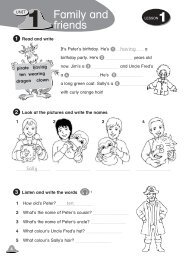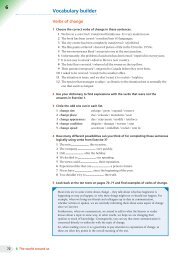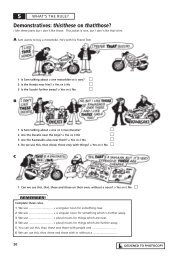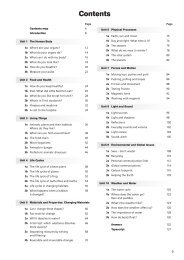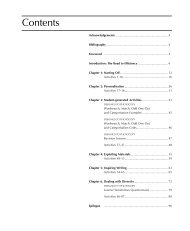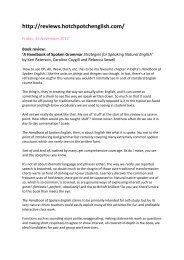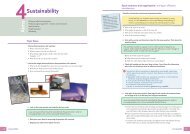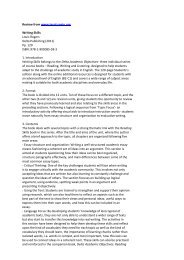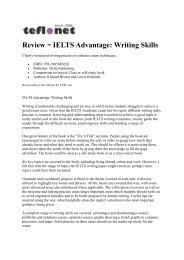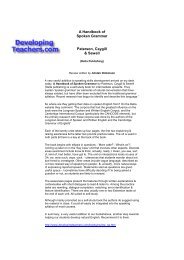The Business English Teacher: English is ... - Delta Publishing
The Business English Teacher: English is ... - Delta Publishing
The Business English Teacher: English is ... - Delta Publishing
Create successful ePaper yourself
Turn your PDF publications into a flip-book with our unique Google optimized e-Paper software.
<strong>The</strong> <strong>Business</strong> <strong>Engl<strong>is</strong>h</strong> <strong>Teacher</strong>:<br />
Professional principles and practical procedures<br />
D e b b i e Ba r t o n , Je n n i f e r Bu r k a r t & Ca i r e e n Se v e r<br />
<strong>Delta</strong> Publ<strong>is</strong>hing 2010<br />
R e v i e w e d b y Ia n Ai r d<br />
<strong>Engl<strong>is</strong>h</strong> <strong>is</strong> inarguably the lingua franca of the business world – and th<strong>is</strong> means many<br />
people throughout th<strong>is</strong> business world need <strong>Engl<strong>is</strong>h</strong> lessons. It also means <strong>Engl<strong>is</strong>h</strong><br />
teachers can travel the world having a fascinating life teaching bankers in Berlin, jamón<br />
serrano exporters in Barcelona, university students in Bogotá or would-be immigrants<br />
in Sydney. But it can be difficult for teachers to move from general <strong>Engl<strong>is</strong>h</strong> into business<br />
<strong>Engl<strong>is</strong>h</strong>, just as it <strong>is</strong> to move into <strong>Engl<strong>is</strong>h</strong> for academic purposes or exam preparation<br />
courses. Many teachers are nervous or feel they are inadequately qualified so they<br />
are reluctant to take or seek opportunities to teach business <strong>Engl<strong>is</strong>h</strong>. Others jump<br />
in unprepared and struggle with course content and delivery methods, fail to sat<strong>is</strong>fy<br />
students, and end up with quite negative perceptions of th<strong>is</strong> specialty. <strong>The</strong> <strong>Business</strong><br />
<strong>Engl<strong>is</strong>h</strong> <strong>Teacher</strong> <strong>is</strong> of great value in addressing both of these <strong>is</strong>sues. It provides insights,<br />
methods, lessons and ideas that can take several years of business <strong>Engl<strong>is</strong>h</strong> teaching to<br />
acquire. It focuses on meeting students’ needs hol<strong>is</strong>tically, and clarifies what a teacher<br />
needs to be, know and do, whilst also providing a wealth of practical material.<br />
<strong>The</strong> <strong>Business</strong> <strong>Engl<strong>is</strong>h</strong> <strong>Teacher</strong> <strong>is</strong> well organ<strong>is</strong>ed. It starts with an introduction to the world<br />
of business <strong>Engl<strong>is</strong>h</strong> teaching. <strong>The</strong>n there are sections on teaching lower level students,<br />
the key business <strong>Engl<strong>is</strong>h</strong> focus areas, and on <strong>Engl<strong>is</strong>h</strong> language and skills development<br />
with a business focus. Each of these three sections <strong>is</strong> made up of outlines of lessons<br />
or tasks for use with a range of students (in fact the bulk of the book’s pages are very<br />
practical classroom activities or lessons). Finally there <strong>is</strong> a small section focusing on<br />
continuing professional development.<br />
EA Journal Volume 27 No 1 89
<strong>The</strong> introduction gives a ‘who, what, where and how’ of business <strong>Engl<strong>is</strong>h</strong> teaching.<br />
Th<strong>is</strong> <strong>is</strong> invaluable for teachers new to the field or wanting to move into the field. It<br />
would even be of value to teachers whose experience of business <strong>Engl<strong>is</strong>h</strong> teaching<br />
has been in a limited context, such as teachers who have only taught non-working<br />
students as opposed to experienced business people or vice versa. <strong>The</strong> three sections<br />
of lesson activities are all very clearly formatted. <strong>The</strong>y all have simple, clear procedures<br />
and, as a rule, require few resources to employ. <strong>The</strong>y very often have suggestions for<br />
adaptations for different student levels, needs, business experience and so on.<br />
One <strong>is</strong>sue perhaps <strong>is</strong> that there <strong>is</strong> often little support for teachers in terms of following<br />
good methodology when using the lesson materials. <strong>Teacher</strong>s will need to put in a fair<br />
amount of work planning many of the tasks despite how straightforward the lessons<br />
may sound. One example of a trap for newer teachers <strong>is</strong> the procedure: ‘have your<br />
students read the text for the general idea’. Given th<strong>is</strong> so-called ‘task’, the majority of<br />
students will naturally read very thoroughly. Likew<strong>is</strong>e, the instruction ‘when learners<br />
have difficulty pronouncing key words, drill them…’ <strong>is</strong>n’t really specific enough for<br />
a less experienced teacher, who may need strategies to help learners with problem<br />
phonemes, word stress and so on.<br />
Another <strong>is</strong>sue <strong>is</strong> that the bulk of the material <strong>is</strong> really aimed at students who are<br />
currently working in business positions with <strong>Engl<strong>is</strong>h</strong> needs, and the tasks involve<br />
students bringing material from their job to work on in lessons. In Australia, the<br />
majority of business <strong>Engl<strong>is</strong>h</strong> students are not working at the time of their study and<br />
some have no business experience at all. Th<strong>is</strong> means teachers will need to source or<br />
make ‘authentic’ business materials, such as emails and financial reports, to be able<br />
to use these lessons. Th<strong>is</strong> will involve quite a bit of work and a real reduction in the<br />
motivational impact of the materials.<br />
Finally, the section on professional development <strong>is</strong> a bit too basic. For most teachers<br />
it’s a given that they should evaluate their lessons after teaching (although they may<br />
not do it) and that observing other teachers <strong>is</strong> a good idea. Likew<strong>is</strong>e, reading the<br />
business section of newspapers to keep abreast of topics <strong>is</strong> nothing groundbreaking.<br />
<strong>Teacher</strong>s would need to look elsewhere for more useful ways to continue to develop<br />
their teaching.<br />
Overall, th<strong>is</strong> <strong>is</strong> a very valuable, long overdue publication. Its contents address things<br />
either not focused on by other resources or not brought together in one book before.<br />
For colleges that have or w<strong>is</strong>h to have business <strong>Engl<strong>is</strong>h</strong> courses, it’s an affordable<br />
teaching and training resource. For teachers, it’s a great tool for a confident and<br />
effective entry to th<strong>is</strong> large, lucrative, and fascinating area of teaching.<br />
90<br />
EA Journal Volume 27 No 1
Ian Aird <strong>is</strong> a teacher trainer at the Australian TESOL Training Centre,<br />
Sydney. He has taught and managed <strong>Business</strong> <strong>Engl<strong>is</strong>h</strong> courses in<br />
Australia and overseas.<br />
<strong>Engl<strong>is</strong>h</strong> Grammar in Use Activities App<br />
&<br />
<strong>Engl<strong>is</strong>h</strong> Grammar in Use Tests App<br />
B rigit Vi n e y & Mi l e s Cr a v e n<br />
Cambridge University Press 2010<br />
R e v i e w e d b y De n i s e No r t o n<br />
Raymond Murphy’s <strong>Engl<strong>is</strong>h</strong> Grammar in Use self-study text <strong>is</strong> a classic. First publ<strong>is</strong>hed<br />
in 1985, it <strong>is</strong> now in its third edition and still going strong, so it’s no wonder that<br />
CUP chose to broach the app market with a companion to th<strong>is</strong> text. <strong>The</strong>re are, in<br />
fact, six apps – elementary, intermediate and advanced Activities apps, each with a<br />
corresponding Tests app. Th<strong>is</strong> review looks at the intermediate level apps.<br />
EA Journal Volume 27 No 1 91




